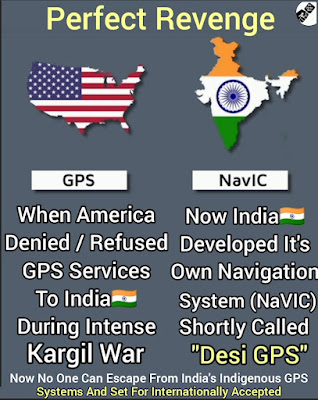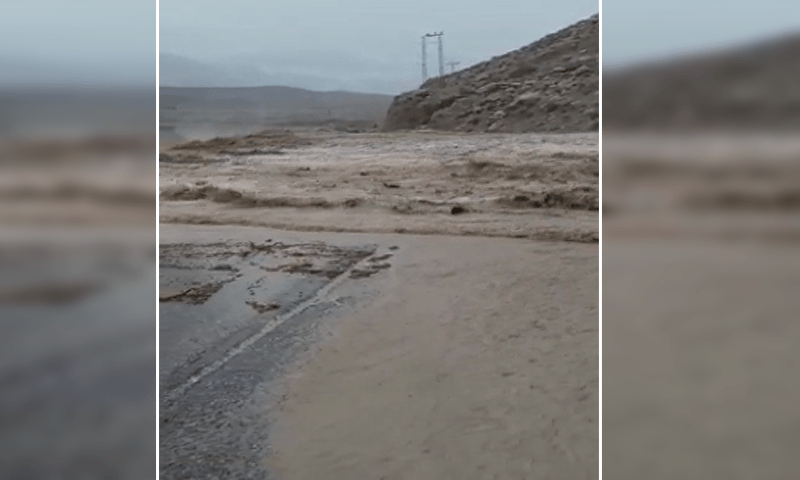Denied GPS During Kargil War By US, ISRO Developed NavIC
NavIC was developed partly because access to foreign government-controlled global navigation satellite systems is not guaranteed in hostile situations, as happened to the Indian military in 1999 when the US denied the Indian request for Global Positioning System (GPS) data for the Kargil region.
NavIC, an acronym of the 'Navigation with Indian Constellation) is an autonomous regional satellite navigation system that provides India with real-time positioning and timing services. NAVIC is the operational name of the Indian Regional National Satellite System (IRNSS), cover India and an area of 1500 kilometres around it, and is under discussion for further expansion. Currently, NAVIC has seven satellite constellations and two satellites on the ground that are kept on stand-by. It would provide two levels of service, 'the standard positioning service' that would be open for civilian use. Still, the local service would only be for authorised users, for instance, the military.Why Was NavIC Developed?
NavIC was developed partly because access to foreign government-controlled global navigation satellite systems is not guaranteed in hostile situations, as happened to the Indian military in 1999 when the United States denied the Indian request for Global Positioning System (GPS) data Kargil region. India could have had access to vital information had the US shared its GPS. Therefore, the Indian Government approved the project in 2013.
On May 28, 2013, the Indian Space Research Organization (ISRO) opened a new facility within their Deep Space Network (DSN) as a part of the project. A network of 21 ranging stations across the country would provide data for the orbital determination of the satellites and monitoring the navigation signal. While three satellites are in the geostationary orbit of the Indian Ocean, their location in low altitude positions would facilitate low-inclination satellites. NavIC currently consists of 8 Satellites – IRNSS-1A, IRNSS-1B, IRNSS-1C, IRNSS-1D, IRNSS-1E, IRNSS-1F, IRNSS-1G, IRNSS-1I.Cost Of The System
Each satellite cost nearly $20 million, whereas the ground segment cost $40 million, thus taking the cumulative cost up to the US $189 million. Initially, NavIC was supposed to have seven satellites and two backup satellites. However, the atomic clock of IRNSS 1A, the first satellite, stopped working, and IRNSS 1H was found to be defective at the time of the launch. After that, the sudden demand for the backup satellites' release and PSLV-XL launches has altered the original budget. The Comptroller and Auditor General of India (CAGI) has to update the cost to the Government, which was $298 million.
The Global Positioning System monitors the entire globe and is monitored by the United States of America. The system needs nearly 24 operational satellites and has 31 satellites in orbit. All the 55 satellites are geosynchronous satellites, which means that they do not remain stationary in space regarding the revolving earth. Moreover, the GPS uses a single frequency which is more complex.
On the other hand, India's NavIC has four geosynchronous and three geostationary satellites. Since all these satellites are placed in a higher orbit, there are lesser chances of obstruction. Compared to the GPS, the NavIC used two frequency bands, the L5 band and the S-Band, making the system more accurate and reliable. The accuracy rate of NavIC compared to that of GPS, because of which it might not show a drastic improvement. However, the location accuracy of NavIC might see a drastic improvement in urban locations where geolocation accuracy tends to degrade.
In India, commercial vehicles are mandated to have NavIC-based trackers, and several mobile phone companies are also launching phones with the tracking service for the first time. In 2010, the Government reported that it would start launching satellites by 2011, at a rate of one satellite launch every six months. At the given speed, the program should have been completed by 2015. However, the program got delayed, and the Government launched another three satellites to supplement the project. The first satellite, IRNSS 1 A, was launched in July 2013, and the second satellite was launched in April 2014 on a PSLV-4 rocket.
Accuracy Of NavIC Compared To GPS
As far as the accuracy is concerned, the system is designed to provide an absolute position accuracy of fewer than 10 metres on the Indian landmass and less than 20 metres in the Indian Ocean. Moreover, it would also cover a region expanding to over 1,500 km. In 2017, the Space Applications Centre said that NavIC would provide accurate positioning service to its users of 5 metres compared to 20 to 30 metres offered by the GPS when a low-frequency signal travels through the atmosphere, its velocity changes due to atmospheric disturbances.
While the United States bank on atmospheric pressure to assess frequency error, it has to keep updating its system from time to time to determine the exact error. In India's case, the actual delay is assessed by measuring the difference in delay of the two frequencies (S and L bands). Therefore, NavIC is not dependent on any model to find the frequency error and is more accurate than GPS. The first failure occurred in 2016, in which all the three SpectraTime supplied rubidium atomic clocks onboard IRNSS-1A had failed, which rendered the satellite useless and had to be replaced.



Comments
Post a Comment